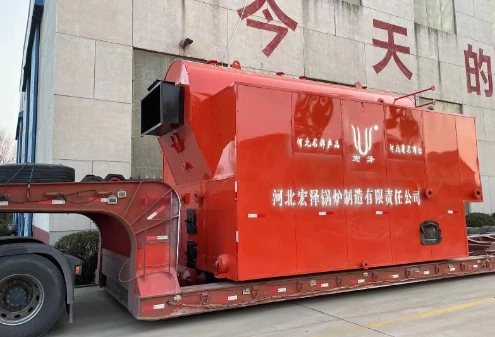
ທ.ວ. . 12, 2024 09:50 Back to list
steam boiler components and functions
Understanding Steam Boiler Components and Their Functions
Steam boilers are integral to various industrial applications, providing essential heat energy for processes ranging from electricity generation to heating systems in residential and commercial settings. The efficiency and safety of steam boilers depend heavily on their components and how they work together. In this article, we’ll delve into the critical components of steam boilers and outline their functions.
1. Boiling Vessel
At the heart of any steam boiler is the boiling vessel, a closed container where water is heated and converted into steam. The design of the boiling vessel is crucial; it must withstand high temperatures and pressures. Typically constructed from robust materials like steel, the vessel is equipped with insulation to minimize heat loss. It also features various fittings for gauges and safety devices, ensuring the system operates safely and efficiently.
2. Burner
The burner is a vital component that introduces fuel (usually natural gas, oil, or coal) into the boiler. It plays a key role in controlling the combustion process, which generates the heat required to convert water into steam. Burners can be categorized into different types based on fuel used and the method of combustion. The efficiency of the burner directly affects the overall efficiency of the steam boiler.
3. Combustion Chamber
Following the burner, the combustion chamber is where the fuel and air mix and ignite. This chamber is designed to maximize heat transfer to the water in the boiling vessel while minimizing the emission of pollutants. The design often includes baffles and other structures that ensure thorough mixing and even distribution of heat, contributing to the boiler's operational efficiency.
4. Heat Exchanger
The heat exchanger enhances the efficiency of the steam boiler by utilizing the heat generated during combustion. This component transfers heat from the combustion gases to the water within the boiling vessel. The most common design for industrial boilers is the fire-tube and water-tube configuration, each designed to optimize heat transfer while minimizing emissions.
steam boiler components and functions

5. Water Supply System
A reliable water supply system is crucial for the operation of a steam boiler. This system typically includes feedwater pumps, which supply water from a storage tank to the boiling vessel. Freshwater is essential to replace what is lost during steam production. The feedwater must be treated to remove impurities that can cause scaling or corrosion within the boiler, thereby prolonging its lifespan and performance.
6. Control Systems
Modern steam boilers are equipped with sophisticated control systems that monitor and regulate various parameters, including pressure, temperature, and water levels. These systems ensure that the boiler operates safely and efficiently, automatically adjusting the fuel supply and water input as needed. Advanced systems may also feature alarm mechanisms that alert operators to any discrepancies, ensuring prompt corrective action can be taken.
7. Safety Valves
Safety valves are critical for the safe operation of steam boilers. They automatically release steam when pressure exceeds a predetermined level, preventing potential explosions and ensuring the integrity of the boiler system. These valves are rigorously tested and must comply with safety standards to protect both the equipment and personnel.
8. Blowdown System
Over time, impurities from the feedwater can concentrate in the boiler, leading to scaling and operate efficiency issues. The blowdown system allows operators to remove a portion of the water from the boiling vessel to manage the concentration of dissolved solids. This process helps maintain the quality of steam produced and extends the life of the boiler.
Conclusion
In conclusion, understanding the components and functions of steam boilers is vital for anyone involved in their operation and maintenance. From the boiling vessel and burner to the safety valves and blowdown systems, each element plays a crucial role in the effective and safe generation of steam. As industries continue to evolve and focus on energy efficiency and sustainability, advancements in steam boiler technology and design will remain essential for meeting modern energy demands.
-
High-Efficiency Commercial Oil Fired Steam Boiler for Industry
NewsJul.30,2025
-
High-Efficiency Biomass Fired Thermal Oil Boiler Solutions
NewsJul.30,2025
-
High Efficiency Gas Fired Thermal Oil Boiler for Industrial Heating
NewsJul.29,2025
-
High-Efficiency Gas Fired Hot Water Boiler for Sale – Reliable & Affordable
NewsJul.29,2025
-
High Efficiency Biomass Fired Hot Water Boiler for Industrial and Commercial Use
NewsJul.29,2025
-
High-Efficiency Biomass Fired Hot Water Boiler for Industrial Use
NewsJul.28,2025
Related PRODUCTS






















